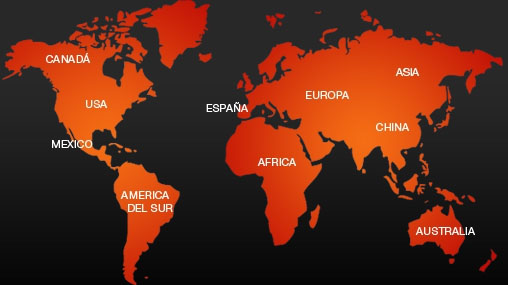- Inicio Acerca de RM Minerales
- Galería de fotos Blog RM Contacto
- Microscopia e instrumentos Pedidos Aviso legal
Copyright 2010-2025
www.rosellminerals.com



Espectacular ejemplar de fergusonita-(Y), un poco habitual niobato de itrio, que habitualmente se presenta masivo o formando pequeños cristales. En este ejemplar podemos observar diversos cristales en crecimiento paralelo. Procede de la colección Jean Béhier (1903-1963), mineralogista francés autodidacta, el cual reunió una colección de más de 5000 ejemplares, principalmente de minerales malgaches. Esta colección se formó gracias a sus numerosos estudios de campo y a los múltiples intercambios que realizó durante su vida. Una pieza top para la especie y la localidad.
Grupo de cristales de betafita de buen tamaño que muestra definidas las caras del octaedro (triangulares) y las del dodecaedro más desarrolladas. Interesante cristalografía. Una pieza de una tamaño excepcional, antigua, clásica e imprescindible en cualquier colección.
Aunque el término betafita fue desacreditado en 2010, muchos seguimos utilizando esta palabra para definir este mineral cuando lo vemos. En nuestro caso tenemos un óxido de uranio, calcio, titanio y niobio/tántalo, con actividad radioactiva. Actualmente la betafita se incluye como una variedad dentro del extenso grupo del pirocloro. Comentar que la variedad más rica en uranio se ha encontrado sólo en la Luna (oxiuranobetafita).
ATENCIÓN: Este ejemplar sólo se enviará a compradores dentro de la península ibérica o recogida en persona.
Cristal de monazita-(Ce) rico en caras, con brillo y color marrón intenso. Encontrar ejemplares con esta calidad no es fácil. Estos ejemplares han sido analizados, indicando que el cerio es predominante, y que se acompaña de otras REE como lantano y neodimio, junto con torio, lo que le confiere cierta radioactividad. Enviaremos los resultados y etiquetas al comprador.
Cristal de monazita-(Ce) rico en caras, con brillo y color marrón intenso. Encontrar ejemplares con esta calidad no es fácil. Estos ejemplares han sido analizados, indicando que el cerio es predominante, y que se acompaña de otras REE como lantano y neodimio, junto con torio, lo que le confiere cierta radioactividad. Enviaremos los resultados y etiquetas al comprador.
Cristal de monazita-(Ce) rico en caras, con brillo y color marrón intenso. Encontrar ejemplares con esta calidad no es fácil. Estos ejemplares han sido analizados, indicando que el cerio es predominante, y que se acompaña de otras REE como lantano y neodimio, junto con torio, lo que le confiere cierta radioactividad. Enviaremos los resultados y etiquetas al comprador.
Estos ejemplares proceden de un hallazgo antiguo en la zona de Felhuns. Se trata de un skarn donde aparecieron vetas de granate. Actualmente está totalmente prohibido extraer ejemplares, debido, como sucede a menudo, a los actos de desaprensivos que no sólo extraen ejemplares sino que destrozan el lugar. Se trata de cristales dodecaédricos a menudo biselados por el trapezoedro, muy brillantes, con un color de miel tostada muy intenso, con cierta transparencia. Serrado por atrás. Se han analizado y los resultados indican una proporción andradita-grosularia alrededor del 65-35% (anàlisis RM333A).
Estos ejemplares proceden de un hallazgo antiguo en la zona de Felhuns. Se trata de un skarn donde aparecieron vetas de granate. Actualmente está totalmente prohibido extraer ejemplares, debido, como sucede a menudo, a los actos de desaprensivos que no sólo extraen ejemplares sino que destrozan el lugar. Se trata de cristales dodecaédricos a menudo biselados por el trapezoedro, muy brillantes, con un color de miel tostada muy intenso, con cierta transparencia. Se han analizado y los resultados indican una proporción andradita-grosularia alrededor del 65-35% (anàlisis RM333A).
Estos cristales de scheelita son clásico de la mineralogía asiática, muy difíciles de ver hoy en día. En esta pieza vemos diversos cristales octaédricos de scheelita, junto con pequeños cristales de fluorita y algun grupo de arsenopirita de mayor tamaño. Con moscovita. Presenta fluorescencia bajo la luz UV-OC. Perteneció a la colección de Arthur Didisheim (Suiza).
Yacimiento de tungsteno en filones de cuarzo. La mina inició sus labores en 1902 y se abandonó en 1973. Las escombreras se recuperaron en el año 2000 y ahora están prácticamente cubiertas de vegetación (MINDAT).
Especimen de violana procedente de la primera localidad donde se describió esta variedad de clinopiroxeno por primera vez. Se trata de diópsido, augita u onfacita de color púrpura a azul púrpura coloreado por manganeso. Este ejemplar que ofrecemos se acompaña de una etiqueta de Deyrolle (París) con el número 3606 (adherido al ejemplar). La compañía Deyrolle inició su andadura en 1831, de la mano de Jean-Baptiste Deyrolle, con la elaboración y venta de materiales relacionados con las ciencias naturales. Este ejemplar se acompaña de una elegante etiqueta manuscrita.
El nombre original es "violan", introducido en 1838 por August Breithaupt. En 1867, Thomas Allison Readwin, en su Index to Mineralogy, escribió mal el nombre con una "e" al final, pero así quedó para el futuro.
Ejemplar muy estético formado por numerosos cristales de calcopirita, brillantes y con formas tetraédricas. Se acompañan de cristales de esfalerita. Desatacan algunos cristales hexagonales, parcialmente corroídos, de fluorapatito, fluorescentes bajo la luz UV-OL. Una pieza brillante para observar bajo aumento.
Esta mina está ubicada en la zona sur del distrito de Huarón, aunque no operada por la misma empresa que explota otras minas de la zona. El término "mina Alimón" es inapropiado y se encuentra a menudo en la literatura. Explotan depósitos primarios hidrotermales de Pb-Zn-Cu-Ag. Ubicada a 3 km al SSO de la mina Huarón.
Ejemplar muy estético formado por numerosos cristales de calcopirita, brillantes y con formas tetraédricas. Se acompañan de numerosos cristales cúbicos de pirita, con las caras estriadas. También cristales de esfalerita negra. Desatacan algunos cristales hexagonales, parcialmente corroídos, de fluorapatito, fluorescentes bajo la luz UV-OL. Una pieza brillante para observar bajo aumento.
Esta mina está ubicada en la zona sur del distrito de Huarón, aunque no operada por la misma empresa que explota otras minas de la zona. El término "mina Alimón" es inapropiado y se encuentra a menudo en la literatura. Explotan depósitos primarios hidrotermales de Pb-Zn-Cu-Ag. Ubicada a 3 km al SSO de la mina Huarón.
Cristal idiomórfico de calcopirita, de un tamaño considerable, con caras y aristas definidas. Algunas muestran crecimientos escalonados. Se dispone de forma muy aérea sobre una matriz formada por cristales de cuarzo hialino, transparentes, brillantes y elongados. Procede de la colección del ingeniero Franco Betta (Torino, Italia).
En este ejemplar podemos observar y disfrutar de numerosos cristales de andradita, de la variedad verde demantoide. Facetados, brillantes y translúcidos. Un clásico alpino. Procede dela colección Didisheim, de Suiza.
Este ejemplar es una muestra extraída de los yacimientos de mercurio de la zona de Guelma, en Argelia, muy probablemente antes de mediados de los años 50 del s. XX. La etiqueta manuscrita que lo acompaña indica que procede de la zona de Guelma, y de la colección de Jean Chervet (1904-1962). Chervet, cuyo nombre identifica el mineral chervetita, fue un mineralogista y coleccionista francés, director del Servicio de Mineralogía de la Comisión de Energía Atómica en Francia desde 1948.
Se trata de una pieza compacta de cinabrio, con crostas pulverulentas rojas y pequeños cristales. Se acompaña de cristales incoloros de cerusita y de 'bindheimita' amarilla y pulverulenta (analizado SEMEDS). Seguramente procede delas prospecciones de Djebel Taya. Un especímen interesante como especie, procedencia y colección.
Los cristales de titanita de esta localidad malgache son muy desconocidos por los coleccionistas. Se trata de un grupo de cristales de muy buen tamaño, con caras definidas y color marrón, que aparecen dentro de una matriz con calcita, escapolita y diópsido. Una pieza muy interesante, tanto por su localidad como por el tamaño y hábito poco común de la titanita. Se identificava como procedente de Fort Dauphin. El distrito de Amboasary es famoso por sus numerosos depósitos de torianita y flogopita.
Muy buen ejemplar formado por una drusa de cristales de vanadinita arsenical de esta clásica localidad mexicana. Se trata de cristales abarrilados, con las terminaciones apuntadas y un brillo notable. El color marrón chocolate muy uniforme. Cuesta ver estos ejemplares hoy día.
Agregado de cristales de esfalerita, de un tono marrón oscuro, situados en una matriz de cristales de dolomita. Al atravesarlos la luz dejan ver ese tomo de miel tostada característico.
Un ejemplar muy interesante de esta zona alpina suiza. Se trata de diversos cristales de diópsido rico en cromo, con cristales brillantes y definidos, que se hallan parcialmente recubiertos de calcita. Una pieza para los coleccionistas de localidades poco represenatdas en colecciones.
Grupo de cristales de esfalerita, complejos, interpenetrados y con caras del dodecaedro. El ejemplar es translúcido, con lo que la luz al atravesar-lo deja ver ese luminosidad naranja que hace de estos ejemplares piezas apreciadas por los coleccionistas.
Drusa de cristales de fluorita, con brillo, formas del cubo con biseles del dodecaedro. Color violeta a azulado en función de la luz incidente. De esta localidad clásica asturiana para la fluorita.
Ejemplar muy interesante y chocante de cuarzo en cetro, transparente y que combina un tono ahumado con una zona amatista. Con caras terminales en fantasma... Un verdadera curiosidad procedente de los Urales.
Los ejemplares de celestina de las zonas de Torà e Ivorra son un clásico de la mineralogia catalana. Se han encontrado en diferentes zonas de ambos municipios. Este ejemplar procede de unoas catas que se hicieron cerca de Torà, en unos taludes, hoy día tapados y estando prohibida su búsqueda, debido a los destrozos que algunos buscadores realizaron antaño. Cristales prismáticos apuntados, de color ligeramente gris azulado, en las cavidades tapizadas de calcita, en una matriz de marga carbonatada.
Los ejemplares de celestina de las zonas de Torà e Ivorra son un clásico de la mineralogia catalana. Se han encontrado en diferentes zonas de ambos municipios. Este ejemplar procede de unoas catas que se hicieron cerca de Torà, en unos taludes, hoy día tapados y estando prohibida su búsqueda, debido a los destrozos que algunos buscadores realizaron antaño. Cristales prismáticos apuntados, de color ligeramente gris azulado, en las cavidades tapizadas de calcita, en una matriz de marga carbonatada.
Excepcional ejemplar de cuarzo, con prismas alargados, formando agregados divergentes, transparentes a translúcidos. Con una tonalidad ligeramente rojiza debido a la presencia de hematites que salpica los cristales. Se acompaña de pequeños cristales de pirita y calcopirita. Un ejemplar de vitrina de esta clásica localidad peruana.
Ejemplar de fluorita de muy buen tamaño formado por diversos cristales cúbicos, en crecimiento paralelo y escalonados. Con caras con crecimientos polisintéticos y aristas biseladas por el dodecaedro. Transparentes y con brillo. El color interno es ligeramente violeta, dependiendo d ela luz, pero la fluorita es incolora, como es habitual en este yacimiento asturiano. Se acompaña de diversos cristales prismáticos de barita, de buen tamaño, salpicados por pequeños cristales de calcopirita. Un ejemplar muy estético.
